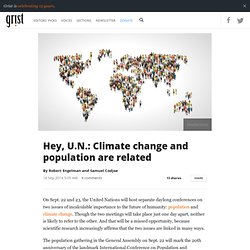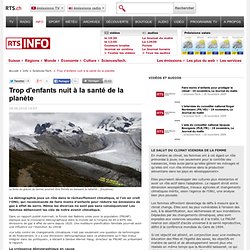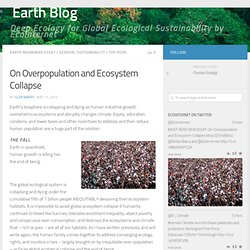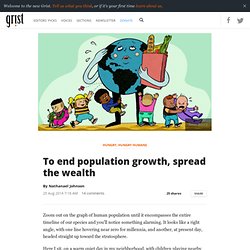

Climate and population are linked — but maybe not the way you thought. The obvious relationship between climate and family planning — and why we don’t talk about it. Several years ago, Bill Gates keynoted a breakfast for Seattle-based Climate Solutions, a nonprofit focused on advancing the clean energy economy and driving practical, profitable solutions to climate change.

Gates opened his speech with an equation. To paraphrase: Our carbon problem = persons x services x the energy intensity of services x the carbon intensity of energy. The number of people is growing, Gates observed, and we all want more services. While Americans arguably consume too many goods and services, billions of people currently living in dire poverty need more. He then spent the rest of the time discussing the last two factors in the equation. Hey, U.N.: Climate change and population are related. On Sept. 22 and 23, the United Nations will host separate daylong conferences on two issues of incalculable importance to the future of humanity: population and climate change.

Though the two meetings will take place just one day apart, neither is likely to refer to the other. And that will be a missed opportunity, because scientific research increasingly affirms that the two issues are linked in many ways. The population gathering in the General Assembly on Sept. 22 will mark the 20th anniversary of the landmark International Conference on Population and Development held in Cairo in 1994. The next day’s summit has been convened by U.N.
Secretary-General Ban Ki-moon for government and business leaders to brainstorm ideas for addressing climate change. The coincidence of these meetings occurring a day apart offers a teachable moment for the global decision-makers gathering in New York. That’s a question researchers are beginning to answer. Développement Durable et Equation de Kaya. Le responsable « santé+sécurité+environnement » de mon employeur nous a présenté les 3 piliers du « développement durable » (Ecologique, Economique et Social) avec ce joli graphique : J’ai trouvé très judicieux d’intégrer ainsi le développement durable aux logiques économique et sociale plutôt que de le promouvoir dans un cadre purement écologiste.

En y réfléchissant, je me demande s’il n’existe pas un parallèle avec la fameuse équation de Kaya dont j’ai déjà parlé ici et que je rappelle ci-dessous : En effet, minimiser le facteur CO2/TEP représente le souci écologique de limiter la pollution. Réduire TEP/PIB est un objectif économique : rendre la production moins coûteuse en énergie. PIB/POP est lié à l’objectif social de répartir les richesses, si possible plutôt en enrichissant les pauvres que le contraire … Frenchswop09.pdf (Objet application/pdf) World Population Prospects, the 2010 Revision. Trop d'enfants nuit à la santé de la planète - rts.ch - info - sciences-tech.
La démographie joue un rôle dans le réchauffement climatique, si l'on en croit l'ONU, qui recommande de faire moins d'enfants pour réduire les émissions de gaz à effet de serre.

Même les divorces ne sont pas sans conséquences! Les femmes détiennent les clés de notre avenir climatique. Dans un rapport publié mercredi, le Fonds des Nations unies pour la population (FNUAP) explique que la croissance démographique dans le monde est à l'origine de 40 à 60% des émissions de gaz à effet de serre depuis 1820. Une meilleure planification familiale pourrait avoir une influence sur l'évolution du climat. «La lutte contre les changements climatiques n'est pas seulement une question de technologies et de financement. La croissance démographique en cause «Si la population de la planète se stabilise, par exemple si elle compte un milliard d'habitants en moins par rapport aux projections d'ici 2100, l'impact sera énorme sur le changement climatique», souligne Werner Haug.
On Overpopulation and Ecosystem Collapse. Earth’s biosphere is collapsing and dying as human industrial growth overwhelms ecosystems and abruptly changes climate.

Equity, education, condoms, and lower taxes and other incentives to stabilize and then reduce human population are a huge part of the solution. Earth in overshoot; human growth is killing her; the end of being. The global ecological system is collapsing and dying under the cumulative filth of 7 billion people INEQUITABLY devouring their ecosystem habitats. To end population growth, spread the wealth. Zoom out on the graph of human population until it encompasses the entire timeline of our species and you’ll notice something alarming.

It looks like a right angle, with one line hovering near zero for millennia, and another, at present day, headed straight up toward the stratosphere. Here I sit, on a warm quiet day in my neighborhood, with children playing nearby and a train whistle farther off, living a reasonable, modest life. And yet, at the same time, I, along with you and the rest of us, am plastered against the tip of population rocket powering upward atop megatons of explosive fuel. That graph comes from Joel Cohen’s 1995 book, How Many People Can the Earth Support? Though it’s now almost 20 years old, it’s still incredibly useful in exploring the conflicting answers to that question, because Cohen never takes sides. Cohen is still alarmed by that graph. The climate movement is way too focused on market-based solutions. To market, to market -- or not to market The climate movement is way too focused on market-based solutions There was a time when we met overarching challenges with bold public purpose and concerted action as “we the people.”

When the Depression hit, we created large public works projects, building roads, airports, and power dams. When murderous tyranny threatened the world, we became the arsenal of democracy and won World War II. When Europe was sinking in post-war turmoil, we staged the Marshall Plan to rebuild the continent.